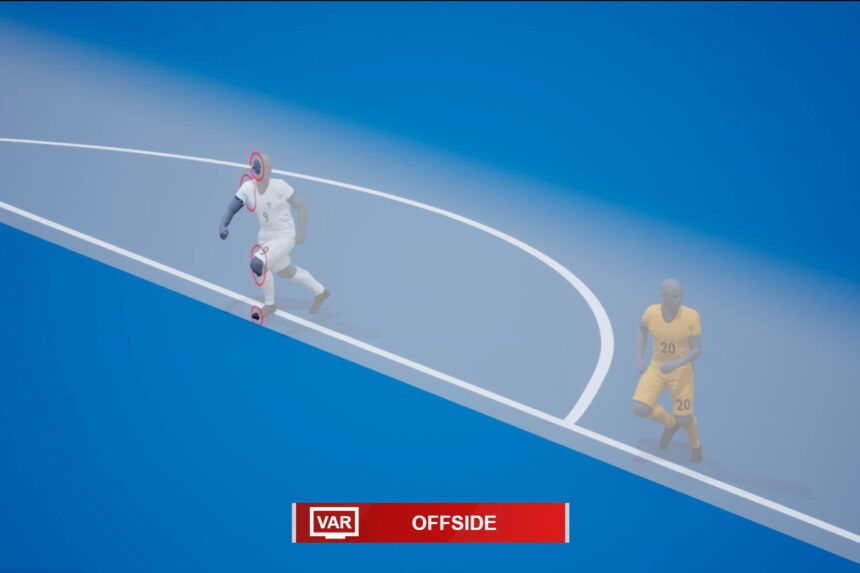The Premier League has confirmed that it will be implementing semi-automated offside technology (SAOT) this season.
The technology will be brought in for matchday 32 and will be used for the first time at the Etihad Stadium, where Manchester City host Crystal Palace in the early kick-off on Saturday April 12.
Advertisement
The system was first introduced in England this season for the FA Cup fifth round but only for fixtures held in stadiums of Premier League clubs. It was also used for during the quarter-final stage of the competition, with the only exception being Championship side Preston North End’s home match against Aston Villa.
A statement on Tuesday read: “The Premier League will introduce semi-automated offside technology on Saturday 12 April (Match Round 32). This follows non-live testing in the Premier League and live operation in the FA Cup this season.
“Semi-automated offside technology automates key elements of the offside decision-making process to support the video assistant referee (VAR). It provides more efficient placement of the virtual offside line, using optical player tracking, and generates virtual graphics to ensure an enhanced in-stadium and broadcast experience for fans.
“The technology maintains the integrity of the process while enhancing the speed, efficiency, and consistency of offside decision-making.
“The Premier League has worked in collaboration with PGMOL and sports data and technology company Genius Sports to develop the new semi-automated offside technology system.”
SAOT was introduced to major competitions in 2022, but did not make its debut in English football until the 2024-25 campaign.
SAOT was used at the 2022 men’s World Cup in Qatar, the women’s World Cup in Australia and New Zealand the following year and at Euro 2024. The technology has also been in use in the Champions League since 2022-23, in Serie A since January 2023 and was brought in by La Liga for the start of the current campaign.
SAOT was first used at the 2022 men’s World Cup in Qatar (Photo: Getty Images)
Premier League clubs unanimously approved the use of SAOT for the 2024-25 season, and while the league initially intended to implement it earlier in the campaign, its introduction was delayed.
“We are not going to introduce it if we’ve got any doubts at all with regards to its operation,” Tony Scholes, the Premier League’s chief football officer, said in February. “The system we’ve adopted, we believe it to be the best system, the most accurate and future-proof system.”
Advertisement
Following its debut in the FA Cup, the Premier League confirmed that it would “look to implement the system later this season.”
There was some controversy during the first weekend of its use, however. Bournemouth’s fifth-round FA Cup clash against Wolverhampton Wanderers on March 1 saw an eight-minute stoppage for a VAR intervention for a goal check in the first half, despite SAOT being intended to reduce delays over contentious decisions.
The Football Association (FA) had previously warned that marginal offside decisions in crowded goalmouths might prove too tight for the new technology to detect, and this was the case at the Vitality Stadium.
VAR instead had to revert to the previous method of drawing lines manually, as Dean Huijsen was adjudged to have been in an offside position when Milos Kerkez’s strike made contact with the Spain international.
After the incident, Bournemouth head coach Andoni Iraola said: “They told us they were going to implement it (SAOT) in the first or the second international breaks this season. Definitely something has not been working well because they’ve decided to put it almost at the end of the season.
“And today, they checked the handball first and they said quickly that it was not a handball, so they were checking the offside. He told us the semi-automatic offside was not working so they have to do the process manually. It has taken a lengthy, lengthy, lengthy drawing.”
Prior to the technology’s trial, the FA also said the technology may not help to shorten delays in certain scenarios, specifically when checking multiple offenses.
“The length of certain VAR checks may also remain where decisions need to consider multiple offside checks or other offenses such as fouls or handballs in the attacking possession phase.”
How does SAOT work?
By explainer journalist Eduardo Tansley
SAOT will automate the job of a replay operator by suggesting a ‘kick-point’ and automatically creating offside lines on the second furthest back defender and the relevant attacker. The Premier League says this will save an average of around 31 seconds per offside.
Advertisement
The SAOT decision is then reviewed and approved by the VAR and automatically creates a visual display shown on stadium screens for fans.
Up to 30 new cameras will be installed around each Premier League stadium to support the system, and many will capture footage at twice the frame rate of typical broadcast cameras — 100 frames per second.
During the two World Cups featuring SAOT, FIFA used ‘connected balls’ with chips in them, to be precise about the ‘kick-point’. But the cameras the Premier League intends to use will track the exact movement of the ball, meaning they do not feel a chip is required.
Players are also continuously tracked using 10,000 data points on the bodies of all 22 players, helping automatically determine whether or not the attacker was offside at the ‘kick-point’ and flagging if any offside player was involved in the build-up to an incident to the VAR and SAOT operator.
SAOT is fully automated and can be overseen by one operator; VAR requires several people to do the job of SAOT manually.
(Top photo: Mike Hewitt/Getty Images)
